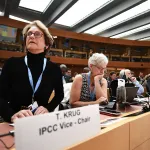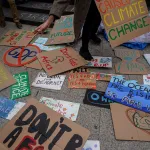A new report that details diversity in environmental organizations found a 3.5 percent increase in staff of color among 68 participating NGOs this year, with a total of 36.5 percent of staff identifying as being a person of color. It also found that representation decreases in more senior levels, with Black, Latinx and Asian-American employees severely underrepresented in executive positions.
But absent from the annual report is any data on gender — in particular where race and gender intersect. It’s a critical missing piece: The climate crisis disproportionately impacts women and LGBTQ+ people, and experts told The 19th that this lack of data can have real world impacts.
The group that issued the report, Green 2.0, which aims to increase diversity within the historically White environmental movement, has tracked and reported gender data in the past. The report plays an important role in holding organizations that shape climate policy accountable to their diversity pledges.
Adriane Alicea, deputy director of Green 2.0, said gender breakdowns were not included in the last two reports because while some organizations provided them, there were some inaccuracies and too much missing data for a meaningful analysis.
“In future report cards, we’re urging environmental organizations and funders to be inclusive and transparent about their gender demographics in order to advance a more diverse climate movement,” she said in an emailed statement. “To achieve this transparency, Green 2.0 is urging NGOs and foundations to include more gender identifiers to make it easier to fully and accurately capture the gender representation of their staff.”
-
More from The 19th
- Representation, protection, restitution: Women lay out key demands at COP27 climate summit
- Working in extreme heat is risky for pregnant workers. Advocates say passing the Pregnant Workers Fairness Act could help.
- NAACP climate director explains why now is the time to fight environmental racism
Steffanie Munguía, student engagement manager with the Citizens Climate Lobby, said Green 2.0 has often “set the tone” for what environmental organizations track.
“I think Green 2.0 collecting that data really sends a really clear message to organizations that that’s something that you should be including in your demographic surveys of staff and board members — and that can really light a fire for organizations that have been dragging their feet around collecting gender data,” Munguía said.
One problem with the data is that many environmental organizations do not provide employees an option to identify outside of the gender binary.
“I empathize with Green 2.0. I know that they’re going to try their best. And they can only move as fast and gather that data as fast as the organizations that they want to include in their report are able and ready,” said Johanna Chao Kreilick, president of the Union of Concerned Scientists, a science-based environmental advocacy organization. “The organizational systems, and the internal data governance and accountability systems [at environmental organizations] aren’t good, they’re still behind the curve ball a little bit,” added Kreilick, who spoke at the event for the report’s release.
Kreilick, who is also the first woman of color to serve as president of Union of Concerned Scientists, said that in addition to updating data collection to reflect diverse gender identities, examining data in an intersectional way is another shift that needs to happen in the environmental movement.
“[In] the broader climate and gender movement, I think we need to be thinking and acting and planning much more at the intersection of issues, because the problems are so complex, and so intertwined, that we’re actually not going to get to where we need to go unless we can actually tackle things in what I like to call a multi solving way,” she said.
While women of color have led on environmental advocacy for decades, at “the Big Greens” — the moniker for some of the largest and most influential environmental NGOs, including the Sierra Club, the Audubon Society and The Nature Conservancy — their representation in leadership positions has been noticeably absent.
Without good data tracking, it’s difficult to say whether strides are being made.
Earlier years of the report — which also polled a smaller number of NGOs — do offer some idea as to what gender trends are within environmental work. The most recent iteration of the transparency report card that contains gender data, from 2020, showed that the numbers of women on boards and senior leadership positions had increased slightly. From 2017 to 2020, organizations reported that on average they added two women to their senior staff and one woman to their boards. That year 43 organizations, including three foundations, voluntarily submitted data. The report card does not shed light on how many of the women are women of color, but Alicea did say that in a preliminary review of this year’s data there are more women of color than men of color working in these environmental organizations.
Munguía, along with others on the virtual call for the report’s release, expressed surprise at the lack of data on gender.
“When we look at the sustainable development goals, and we look at a lot of the work that the global community is kind of coming together to do, a lot of it revolves around women and girls having decision-making power,” said Munguía. “It just seems like a really critically important point of diversity that we should be tracking, because that certainly trickles down and affects how organizations operate. And it affects the culture that we’re creating within those organizations to be the most effective and impactful that we can be.”
Munguía thought back to her own experiences as a woman in the environmental space. She started her environmental activism in middle school. “I was essentially a little girl that was coming into spaces that were mostly older White men. And that really affected the type of work that they thought I was capable of and the type of power and authority that they thought that I should hold in those organizations.”
“Young women still encounter a kind of gender-based discrimination, and certainly as we start to get into other marginalized gender identities that is only further amplified,” Munguía said. “It would be naive and reckless of us to think that this information isn’t important and that type of gender-based discrimination doesn’t happen.”
She now sits on the Audubon Society Board of Directors, where in 2021, an audit commissioned by the board confirmed findings from a Politico investigation that reported on a toxic culture of harassment and fear for women and people of color. That report led to a new CEO, Elizabeth Gray, the first woman to lead the organization in its history.
“The board, and the organization, has taken significant strides since [the] report to remedy the major concerns raised by the findings, as well as a broader commitment from leadership to foster a culture of respect, inclusion, and belonging at the organization,” Munguía said.
Bridget Burns, the director of the Women’s Environment and Development Organization, an international advocacy group that co-launched the Gender and Environment Data Alliance, a project to increase access to gender data, stresses that data helps craft better policy and implement solutions when it comes to increasing representation. It is also an important tool to track and measure any progress.
“And, of course, you know, it’s never just about gender, it’s about multiple intersecting identities. If you look at any studies on effective governance or policymaking, the more you have a diversity of representation of views, the better and more equal the outcomes are going to be,” she said.
Alicea, of the Green 2.0 report, said the environmental movement in the United States needs to view the representation of people of color and people of all genders as a hallmark of a winning movement.
“We need the green movement to reflect the values and needs of these communities who most likely bear the negative impacts of climate change,” she said. “Their community-led solutions are critical to winning on climate and we need to ensure they are widely represented and at the decision-making table.”







